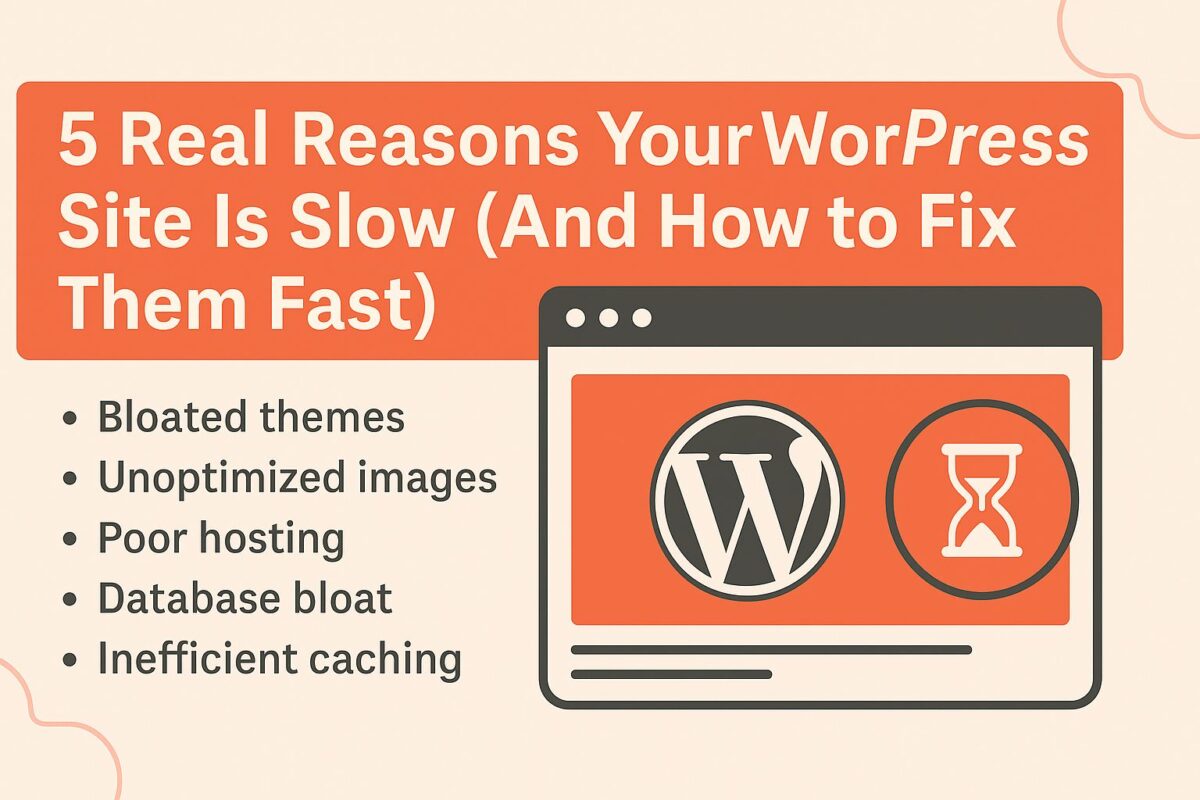5 echte redenen waarom uw WordPress-site traag is (en hoe u ze snel kunt oplossen)

Als uw WordPress-site traag aanvoelt, bent u niet de enige — en dat is niet verzonnen. Paginasnelheid is een cruciale factor voor zowel gebruikers als zoekmachines. Een langzaam ladende website leidt tot gefrustreerde bezoekers, hogere bouncepercentages en lagere rankings. Maar hier is het goede nieuws: de meeste snelheidsproblemen van WordPress zijn te voorkomen en op te lossen. In dit artikel bespreken we vijf echte, onderliggende oorzaken van slechte prestaties – en hoe je ze snel en effectief kunt verhelpen.
1. Opgeblazen thema's en plug-ins
Een van de meest voorkomende oorzaken van een trage WordPress-site is een overbelast thema of te veel actieve plugins. Sommige thema's bevatten tientallen functies die je nooit zult gebruiken, waardoor er op elke pagina extra CSS-, JavaScript- en lettertypebestanden worden geladen. Slecht gecodeerde of onnodige plugins kunnen op dezelfde manier achtergrondprocessen, databasequery's of scripts uitvoeren die je site zwaarder maken.
Hoe het te repareren
- Stap over naar een lichtgewicht, prestatie-geoptimaliseerd thema zoals Astra of GeneratePress.
- Controleer je plug-ins. Deactiveer en verwijder alle plug-ins die je niet gebruikt.
- Gebruik de Querymonitor plugin om te identificeren welke plugins uw site vertragen.
2. Niet-geoptimaliseerde afbeeldingen
Grote afbeeldingsbestanden zijn een stille doder voor de snelheid van je website. Als je foto's rechtstreeks vanaf een telefoon of camera uploadt zonder ze te comprimeren of te verkleinen, kan elke afbeelding meerdere megabytes groot zijn, waardoor pagina's langzaam laden, vooral op mobiele netwerken.
Hoe het te repareren
- Comprimeer afbeeldingen voordat u ze uploadt met hulpmiddelen als TinyPNG of ImageOptim.
- Gebruik moderne formaten zoals WebP voor betere compressie zonder kwaliteitsverlies.
- Implementeer lazy loading, zodat afbeeldingen die niet in beeld zijn pas worden geladen als ze nodig zijn. (WordPress 5.5+ heeft dit standaard.)
3. Slechte hosting en trage TTFB
Je hostingprovider speelt een belangrijke rol in de laadsnelheid van je website. Gedeelde hosting met overvolle servers leidt vaak tot een hoge TTFB (Time to First Byte), waardoor zelfs eenvoudige pagina's binnen enkele seconden worden weergegeven.
Hoe het te repareren
- Een run uitvoeren TTFB-test om de reactietijd van uw server te controleren.
- Upgrade naar een krachtige host met LiteSpeed, NGINX of speciale WordPress-optimalisatie (bijvoorbeeld Cloudways, SiteGround of Rocket.net).
- Gebruik een CDN (Content Delivery Network) zoals Cloudflare om assets sneller wereldwijd te leveren.
4. Database-bloat
Je WordPress-database slaat alles op: instellingen, berichtrevisies, spamreacties, plugingegevens en meer. Na verloop van tijd stapelen deze gegevens zich op, vooral in de wp_options tabel — waardoor query's en beheerprestaties worden vertraagd.
Hoe het te repareren
- Ruim verlopen transients op en plaats revisies met een plugin als WP-Sweep of Advanced Database Cleaner.
- Controleer handmatig grote automatisch geladen vermeldingen met deze SQL-query in phpMyAdmin:
SELECT option_name, LENGTH(option_value) AS size FROM wp_options WHERE autoload = 'yes' ORDER BY size DESC LIMIT 20; - Verwijder of schakel ongebruikte pluginopties uit, maar maak altijd eerst een back-up!
5. Inefficiënte caching en te veel verzoeken
Zonder goede caching activeert elk bezoek aan je site PHP- en databaseverwerking. Dit verspilt tijd en serverbronnen. Bovendien overbelast het laden van meer dan 100 CSS-, JS- of lettertypeverzoeken per pagina browsers en vertraagt het de weergave.
Hoe het te repareren
- Schakel volledige paginacaching in met LiteSpeed Cache, WP Rocket of Powered Cache.
- Verklein en combineer CSS- en JavaScript-bestanden waar dit veilig is.
- Laad lettertypen vooraf en stel niet-kritieke scripts uit met hulpmiddelen zoals Asset CleanUp.
Snelle checklist: is uw site getroffen?
Als u op twee of meer van deze vragen ‘ja’ antwoordt, heeft uw WordPress-site snelheidsverbetering nodig:
- Heeft uw site meer dan 3 seconden nodig om te laden op mobiele apparaten?
- Gebruikt u een thema met functies die u niet nodig hebt?
- Zijn er meer dan 15 plug-ins actief?
- Staat uw beeldbibliotheek vol met bestanden van 1 MB of meer?
- Is uw TTFB boven de 500ms?
- Hebt u uw database nog nooit opgeschoond?
Bonustip: vertrouw niet alleen op Google PageSpeed
Hoewel PageSpeed Insights nuttig is, moeten de echte prestaties worden getest met behulp van:
- Chrome DevTools → tabblad Netwerk: om de werkelijke laadtijden en bestandsgewichten te zien
- GTmetrix: voor visuele watervalanalyses
- WebpaginaTest: voor TTFB, LCP en CLS vanaf verschillende locaties
Laatste gedachten
Snelheid is meer dan een extraatje – het is een rankingfactor, een conversiebooster en een essentiële klantervaring. Als je WordPress-site traag is, installeer dan niet zomaar een plugin. Controleer je stack, schoon je database op, optimaliseer je assets en upgrade waar nodig.
Heeft u hulp nodig om uw site te versnellen? Vraag een gratis audit aan van SpeedWP Pro en laat onze experts precies identificeren wat u tegenhoudt - en hoe u dit snel kunt oplossen.
